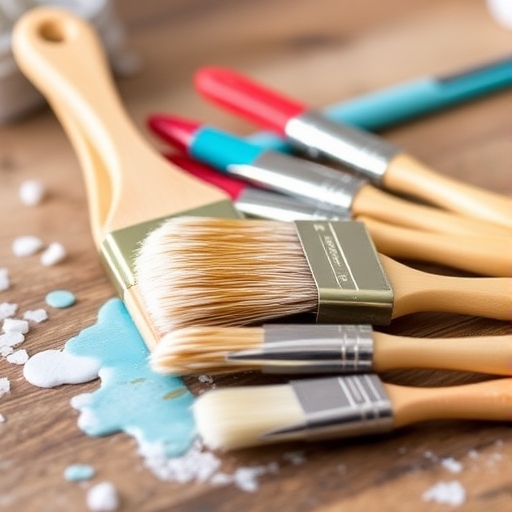The Ultimate Guide to Cleaning Paint Brushes
Maintaining your paint brushes is crucial for their longevity and the quality of your work. A well-cleaned brush will perform flawlessly, delivering smooth strokes and consistent color application. Conversely, neglecting brush cleaning leads to hardened paint, ruined bristles, and ultimately, wasted money.
This comprehensive guide will walk you through the proper techniques for cleaning various types of paint brushes, ensuring your tools remain in top condition for years to come.
Understanding Paint Types and Their Cleaning Requirements
Before diving into the cleaning process, it’s vital to understand that different paint types require different cleaning methods. Using the wrong solvent can damage your brushes irreparably. Here’s a breakdown:
Water-Based Paints (Acrylics, Latex, Tempera): These are generally the easiest to clean, requiring only water and mild soap. However, prompt cleaning is still essential to prevent the paint from drying and becoming difficult to remove.
Oil-Based Paints (Alkyds, Oils): These paints require solvents like mineral spirits, turpentine, or odorless mineral spirits for effective cleaning. These solvents dissolve the oil, allowing for thorough removal of the paint.
Specialty Paints (Enamels, Lacquers): These paints often require specific thinners or solvents recommended by the manufacturer. Always check the paint can for instructions.
Step-by-Step Cleaning Process: Water-Based Paints
Cleaning water-based paints is relatively straightforward, but speed is key. The longer the paint remains on the bristles, the harder it becomes to remove.
1. Immediate Rinse: As soon as you’ve finished painting, rinse your brushes under lukewarm running water. Hold the brush at an angle to allow the water to flow along the bristles, removing as much loose paint as possible.
2. Soap and Water Scrub: Squeeze a small amount of mild dish soap (avoid harsh detergents) onto your palm. Gently work the soap into the bristles, swirling the brush in your hand to distribute the soap evenly.
3. Thorough Rinse: Rinse the brush thoroughly under running water until all traces of soap and paint are gone. You should see clear water running from the bristles. Pay close attention to the ferrule (the metal band connecting the bristles to the handle) to ensure no paint is trapped there.
4. Reshape and Dry: Gently reshape the bristles to their original form. You can use your fingers or a brush comb for this. Then, lay the brush flat or hang it bristles-down to dry completely. Avoid standing the brush upright as this can warp the bristles over time.
Step-by-Step Cleaning Process: Oil-Based Paints
Cleaning oil-based paints requires more care and the use of solvents. Always work in a well-ventilated area, as solvents can release fumes.
1. Initial Solvent Soak: Fill a jar or container with mineral spirits, turpentine, or odorless mineral spirits. Submerge the brush completely, ensuring all the bristles are coated in the solvent. Let it soak for at least 15-30 minutes, or longer for heavily loaded brushes.
2. Solvent Scrubbing: After soaking, gently work the solvent into the bristles using your fingers or a brush comb. This will help loosen and remove the hardened paint.
3. Solvent Rinse: Rinse the brush thoroughly under running water. Continue rinsing until the water runs clear. This step is crucial to remove all traces of solvent, which can interfere with future paint applications.
4. Soap and Water Rinse (Optional): For an extra-thorough clean, follow the solvent rinse with a mild soap and water rinse, as described in the water-based paint cleaning section.
5. Reshape and Dry: Gently reshape the bristles and lay the brush flat or hang it bristles-down to dry completely. Proper drying is essential to prevent solvent residue from damaging the bristles.
Cleaning Specialty Paints
Cleaning specialty paints like enamels and lacquers requires following the manufacturer’s instructions carefully. They often require specific thinners that are designed to dissolve the paint without damaging the brush bristles. These thinners are usually highly flammable and should be handled with extreme caution in a well-ventilated area.
Always refer to the paint can for specific cleaning recommendations. Improper cleaning can ruin your brushes.
Dispose of solvents properly: Never pour solvents down the drain. Follow local regulations for proper disposal of hazardous waste.
Brush Maintenance – Beyond Cleaning
Regular cleaning is essential, but proper brush maintenance extends beyond just cleaning after each use.
Brush Combs: Use a brush comb regularly to remove paint and debris from the bristles. This helps prevent paint buildup and keeps the bristles in good condition.
Storage: Store your brushes properly to prevent damage and maintain their shape. Keep them in a cool, dry place away from direct sunlight.
Conditioning: Some brush manufacturers sell brush conditioners that help maintain the flexibility and longevity of the bristles.
FAQ About Brush Cleaning
Q: Can I use hot water to clean my brushes? A: While hot water can help loosen some paints, it can also damage the bristles of some brushes, especially natural hair brushes. Lukewarm water is generally recommended.
Q: What if I accidentally leave my brushes in paint overnight? A: The longer the paint is left to dry, the harder it becomes to remove. Soaking in the appropriate solvent (water or oil-based thinner) for an extended period might help, but some damage may be irreversible.
Q: How often should I clean my brushes? A: Clean your brushes thoroughly after every use to maintain their quality and extend their lifespan.
Q: My brush bristles are falling out. What should I do? A: This often indicates a problem with either the quality of the brush or improper cleaning and storage. Avoid harsh cleaning methods and ensure proper drying to help prevent this.
Q: Can I use the same solvent for all oil-based paints? A: While mineral spirits generally work for most oil-based paints, some specialized paints may require specific thinners. Always check the paint can for recommendations.
Cleaning Solvents
| Solvent | Paint Type | Advantages | Disadvantages | Safety Precautions |
|---|---|---|---|---|
| Water | Water-Based Paints | Readily available, inexpensive, non-toxic | May not effectively remove stubborn paint | None (except for hot water damage) |
| Mild Dish Soap | Water-Based Paints | Helps emulsify paint for easier removal | Avoid harsh detergents that can damage bristles | None |
| Mineral Spirits | Oil-Based Paints | Effective at dissolving oil-based paints | Flammable, strong odor | Well-ventilated area, keep away from flames |
| Turpentine | Oil-Based Paints | Effective at dissolving oil-based paints | Flammable, strong odor, potentially toxic | Well-ventilated area, keep away from flames |
| Odorless Mineral Spirits | Oil-Based Paints | Effective, less harsh odor than turpentine | Flammable | Well-ventilated area, keep away from flames |
| Manufacturer’s Thinner | Specialty Paints | Specifically designed for certain paints | Often flammable, may have specific hazards | Follow manufacturer’s safety instructions |
By following these guidelines and employing the appropriate cleaning methods for your paint type, you can effectively maintain your paint brushes and enjoy their optimal performance for many projects to come. Remember, a little preventative care goes a long way in preserving your valuable art supplies.

